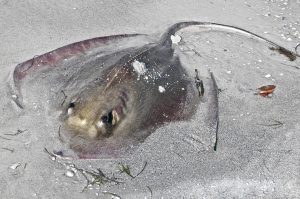On the beach, the sky is so pale that it’s almost indistinguishable from the Gulf water. A Forster’s tern plunges hard at a 90-degree angle into the shallow water very close to shore.
A Sting Ray
There’s a large brown wing just below the ridge of high sand. Is a brown pelican below? Yes. It’s an immature bird with wings partially raised and looks at my wife and me as we walk closer. Tolerating us for a minute, the bird, which goes back in the fossil record at least 30 million years, raises its wings and launches itself, flying down the beach where perhaps a third of a mile later it sets down further back on the sand. Strange, these guys may rest a while on sand but then usually go back to the water.

On the sand is a sight that gives pause to stop and stare—a sting ray. They just don’t wash up. This is the first time in 11 winters here that I’ve seen one dead. It appears to be a bluntnose stingray. Flies buzz around the top of the head where its eyes were. The dull maroon looking creature is about 3-feet wide and a bit longer with a spiny ridge down its back and a whip-like tail partially covered with sand. They have one or more barbed stingers on the tail and two grooves with venom glands on its underside, used in self-defense. These rays move sand beneath the water and conceal themselves there. In death, the tide has partially done the same for it at the water’s edge.
Hungry Ospreys

High above is an osprey with scraggly wing and tail feathers. Its wings are fast beating as it circles, giving the raptor a look of desperation. The “fish-hawk” starts to plunge down fast—it’s seen something. The osprey is in the water for at least five seconds suggesting that it’s grappling with a big fish. Wet wings are beating like mad as the osprey rises slowly, flying low. I don’t have to look closely to see that it’s carrying too much weight. The fish it has snagged is heavy, maybe too much so. The osprey is really in the soup, its back to the wall. Will it have to surrender the prize? Will it try to carry the fish to shore instead of a far away tree branch? Three times the osprey rises above the horizon and each time drops below. However, there’s a steadiness to the bird’s flight and it gradually gains height. Now it has set a definite course, is gaining more height and goes out of sight to either a nest where it will deliver the fish to hungry mouths or to a branch where it will look around nervously and tear into the flesh ripping off red pieces in its cruelly hooked bill.
A few minutes later another osprey appears over the water. This one’s feathers aren’t molting, but have a sheen. It circles for a while and leaves empty-handed. This morning isn’t for healthy looking ospreys but for one that wants it badly enough.
Expert Knowledge
My beach friend Barry, a birder from Thunder Bay, Canada, identifies birds by their sound and visually without the use of binoculars. He points out a tiny white coquina burying itself in the wet sand by the water’s edge. I thought that the coquina was a shell. He’s noticed that there have been a paucity of shorebirds here this winter. There have been no red knots this winter, but I haven’t thought much about it. Come to think of it, there haven’t been that many willets, sanderlings or ruddy turnstones. There have also been almost no sighting of black skimmers which used to cover this beach like so many black ink spots. This is the first time I’m actually thinking about these observations.
The next day a woman, Carol, also a beach friend, is out walking every inch of the beach. Using large tongs, she collects every imaginable shell and creature from the water’s edge, putting them into various tubes and containers. She can identify every one. She tells me that coquina are living creatures and do bury them selves in the sand. Now I’m thinking about the white ibis and small shorebirds that scurry after and probe the sand for these tiny things.
I cut short a photo session with two cormorants that are drying their wings on a seawall, also a rarity here. I want to be home at noon to see the news on the local Sarasota ABC TV station. There are a pair of osprey named Sara and Sota who are nesting on their cam tower. The audience has a live look at the osprey when the station streams it during the hour. The dean of Sarasota birders, John Ginaven, who is a neighbor and with whom I was privileged to do the Christmas Bird Count this past January, is going to be interviewed about ospreys. Ginaven comes on screen wearing jeans and a blue shirt. Beneath his name is the title “Bird Expert.” He looks just as he does when birding and on screen resembles a 1940s college professor. Givanen is talking about how the female, who is incubating the eggs, loses some of her feathers and is doing it with bare skin. He discusses strategies that the osprey and shorebirds use so as not to overheat the eggs when the temperature gets hot. Then he’s talking about egg membranes. I should be taking notes. Ginaven speaks simply and specifically without giving long-winded answers. His demeanor belies his enormous knowledge and his ability to communicate it to non-birders. He’s an excellent ambassador for birding. I’m impressed and more so, proud to know this man. This has been one memorable morning.

































